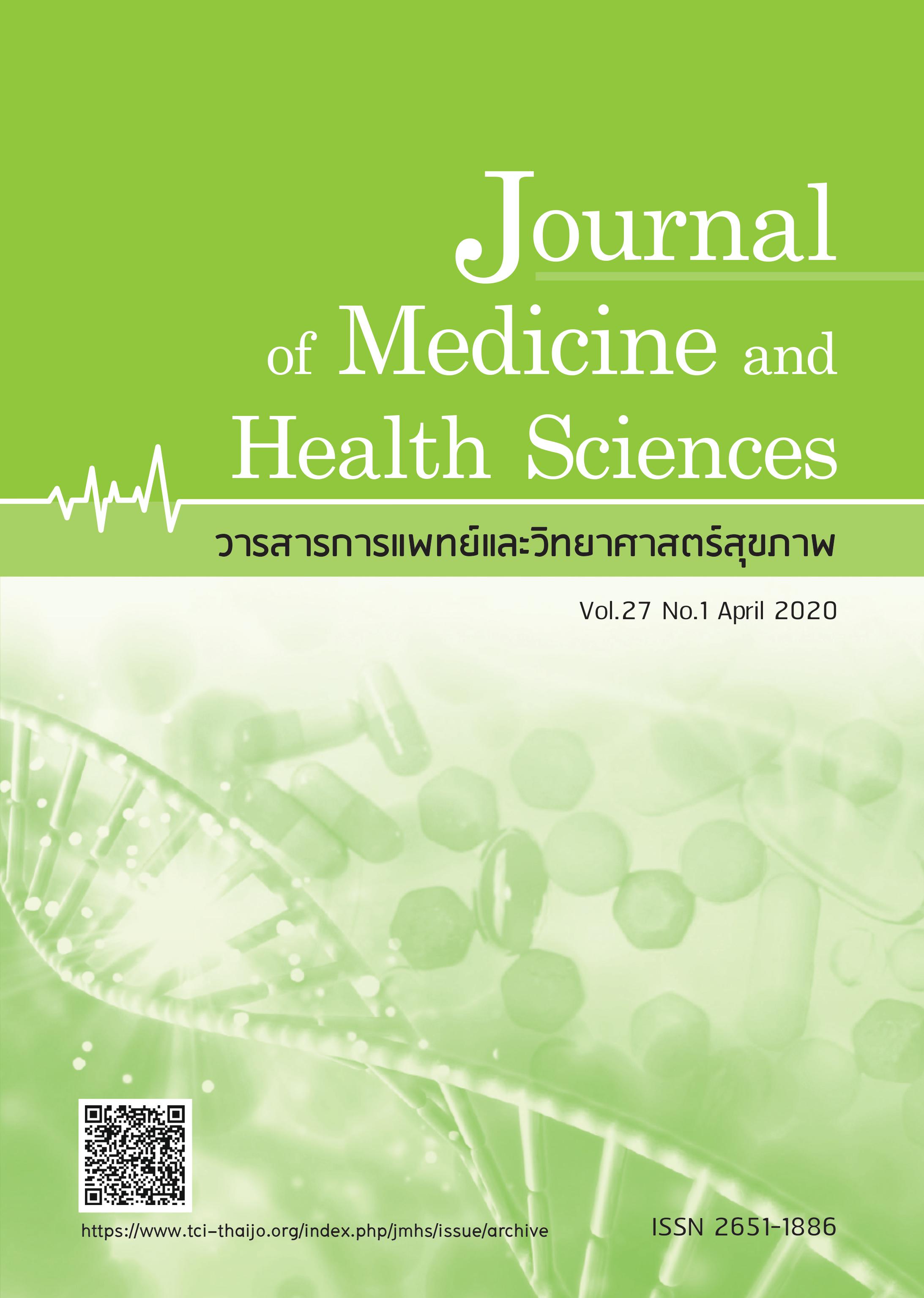Effect of enhancing holistic health promotion program affecting changes in physical fitness for university students
Keywords:
program, holistic health, physical fitness, students, stage of changeAbstract
บทคัดย่อ
การวิจัยเป็นการวิจัยแบบกึ่งทดลองโดยวัดการทดสอบสมรรถภาพทางกายก่อนและหลังการทดลองซึ่งมีวัตถุประสงค์เพื่อศึกษาประสิทธิผลของโปรแกรมสร้างเสริมสุขภาพแบบองค์รวมที่มีต่อการเปลี่ยนแปลงสมรรถภาพทางกายของนักศึกษามหาวิทยาลัย กลุ่มตัวอย่างที่ใช้ในการวิจัยเป็นนักศึกษามหาวิทยาลัยเทคโนโลยีพระจอมเกล้าธนบุรี จำนวน 60 คน ที่มีพฤติกรรมการออกกำลังกายในขั้นที่ 2 ตามทฤษฎีขั้นตอนการเปลี่ยนแปลงพฤติกรรมที่สมัครใจเข้าร่วมโปรแกรมที่ผ่านการตรวจสอบ 4 ด้านคือ ความถูกต้อง ความเหมาะสม ความเป็นประโยชน์และความเป็นไปได้ด้วยผู้เชี่ยวชาญ ประกอบด้วยหัวข้อกิจกรรม 1) วิทยาศาสตร์การกีฬา 2) การออกกำลังกายโดยเวทเทรนนิ่ง 3) การบาดเจ็บจากการออกกำลังกาย 4) การฝึกโยคะ 5) จิตวิทยาในการออกกำลังกาย6) โภชนาการกับการออกกำลังกาย 7) การวิ่งเหยาะ และ 8) การวิ่งมินิมาราธอน หลังจากนั้นทดสอบสมรรถภาพทางกายโดยใช้วิธีการทดสอบที่ดัดแปลงตามเกณฑ์มาตรฐานสมรรถภาพทางกายของประชาชน สำนักวิทยาศาสตร์การกีฬา กรมพลศึกษา จำนวน 8 รายการ ได้แก่ ดัชนีมวลกาย เปอร์เซ็นต์ไขมัน ชีพจรขณะพัก ความจุปอดแรงบีบมือ แรงเหยียดขา ความอ่อนตัว ยืนยกเข่าขึ้นลง 3 นาที วิเคราะห์ข้อมูลโดยใช้การทดสอบ Paired t-testผลการวิจัยพบว่า หลังสิ้นสุดโปรแกรมผู้เข้าร่วมโปรแกรมมีค่าดัชนีมวลกาย เปอร์เซ็นไขมัน ชีพจรขณะพักลดลงอย่างมีนัยสำคัญทางสถิติที่ระดับ 0.05 และมีค่าความจุปอด ความอ่อนตัว แรงบีบตัว แรงเหยียดขา จำนวนการยืนยกเข่าขึ้นลง 3 นาทีเพิ่มขึ้นอย่างมีนัยสำคัญทางสถิติที่ระดับ 0.05 อีกทั้งเพศและอายุมีความสัมพันธ์ต่อสมรรถภาพทางกายของนักศึกษา สรุปได้ว่าโปรแกรมสร้างเสริมสุขภาพแบบองค์รวมมีประสิทธิผลต่อการพัฒนาสมรรถภาพทางกายของนักศึกษา ทำให้สมรรถภาพทางกายดีขึ้นในทุกด้าน และสามารถนำโปรแกรมไปดูแลสุขภาพแบบองค์รวมเพื่อการพัฒนาพฤติกรรมสุขภาพและคุณภาพชีวิตของนักศึกษา
Abstract
The study is a quasi- experimental research that the pre-test and post-test of physical fitness were measured. The objective of this research is to develop and evaluate an enhanced holistic health promotion program affecting changes in physical fitness for university students. There were sixty students from King Mongkut’s University of Technology Thonburi who are in the 2nd step on stage of change theory and voluntarily participated in the program. The effectiveness of program was tested by experts with regard to four aspects: accuracy, propriety, utility and feasibility. All of the students were assigned to the program as follows: (1) sports science; (2) weight training; (3) injuries, exercise and sport; (4) Yoga; (5) psychology of exercise; (6) nutrition and exercise; (7) Jogging; and (8) a mini-marathon. After that, eight test items on physical fitness adapted by testing criteria and benchmarks for physical fitness from the Bureau of Sports Science, Department of Physical Education were studied. It consisted of body mass index, fat percentage, resting pulse, vital capacity, sit and reach, hand grip strength, leg dynamometer test and three minutes step up and down. The data were analysed using Paired t-test. The results found that the students who attended the program had body mass index, fat percentage and resting pulse decreased at a statistical significance level of 0.05, while vital capacity, sit and reach, hand grip strength, leg dynamometer test, three minutes step up and down had increased at a statistical significance level of 0.05. Gender and age were related to the physical fitness of participated students. It can be concluded that the created program had a powerful impact to improve physical fitness in all dimension. It is a holistic healthcare model for develop positive health behaviors and a good quality of life for students.
References
2. Lasuka D, Khampolsiri T, Sucamvang K,et al. Development of leader’s potential in holostic health promotion process of aging in the community. Thai J Nurs Counc 2011;26(Special Issue):59-69.
3. Panyawong K, Pruaksunan P. Holistic health care academic documents. Samut Songkhram: Faculty of Liberal Arts, Learning Institute for Everyone; 2012;p.10.
4. Wasi P. Towards the four dimensions of health in mental, social and spiritual health. Bangkok: Century company limited;2001;p.41.
5. Landrum P, Beck K, Rawlins P, et al. Mental health-Psychiatric nursing: A holistic life-cycle approach. London:Mosby Year Book;1993;p.586-98.
6. Leathard H, Cook M. Learning of holistic care: addressing practical wisdom (phronesis) and the spiritual sphere. J Adv Nurs 2009;65(6),1318-21.
7. Balthip K, Petchruschatachart U,Piriyakoontorn S, et al. Application of the purpose in life model for enhancing holistic health promotion of Thai adolescents living with HIV.
Songklanagarind J Nurs 2018;38(4):49-67.
8. Chachvarat T, Phawong V, Nunta S.Teenagers health behaviors. Nurs Public Health and Educ J 2018;19(3):107-20.
9. Kilpatrick M, Hebert E, Bartholomew J. College students’ motivation for physical activity: Differentiating men’s and women’s motives for sport participation and exercise. J Am Coll Health 2005;54(2):87-94.
10. Boonsem A, Malarat A. Factors affecting the behavior and stages of readiness to change exercise behaviour among university students. Int J High Edu 2018;7(6):191-97.
11. Prochaska JO, Velicer WF. The transtheoretical model of health behavior change. Am J Health Promot 1997;12(1):38-48.
12. Department of Physical education, Ministry of Tourism and sports. Test and benchmark for physical fitness of people aged 19 - 59 years. Bangkok: Bureau of Sports science; 2019.
13. Heetaksorn C, Chantra R, Wanchai A, et al. Exercise behavior modification and application of Transtheoretical model. J Nurs Health Care 2017;35(4):25-33.
14. Dyrstad S, Soltvedt R, Hallen J. Physical fitness and physical training during Norwegian military service. Mil Med 2006;171,736-41.
15. Ramada J, Barac-Nieto M. Reported frequency of physical activity, fitness, and fatness in Kuwait. Am J Hum Biol 2003;15(4).514-21.
16. Wu T, Gao X, Chen. M, et al. Longterm effectiveness of diet plus exercise intervention vs. diet only intervention for weight loss: A metaanalysis. Obes Rev 2009;10:313-23.
17. Donnelly J. Blair S, Jackicic J, et al. American college of sports medicine position stand. appropriate physical activity intervention strategies for weight loss and prevention of weight regain for adults. Med Sci Sports Exer 2009;41(2):459-71.
18. Wongsamsorn T. [Internet]. Doctor invites to lose weight correctly. [cited 2020 January 3] Available from http://www.cigna.co.th/health-wellness/tip;2015.
19. Larry KW, Wilmore JH, Costill DL. Physiology of sport and exercise. 6th ed. Champaign, IL: Human Kinet; 2015.
20. Kritphet T. Choengsajee K. Glossary of sports terms, physical education and sports science. 1st ed. Bangkok: Chulalongkorn university press; 2001;p.430.
21. Yodkham M. Health and exercise. Bangkok: Odeon Store; 2005; p.49.
22. Awilai N, Subprasert V. A Study on physical fitness level and exercising activities of the academic staffs of Kasem Bundit university. J Sport Sci Health 2017;18(3):14-26.



